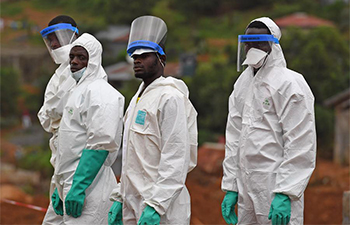SAN FRANCISCO, Aug. 22 (Xinhua) -- In what may be called an unsurprising surprise, a survey of deoxyribonucleic acid (DNA) fragments circulating in the blood suggests the microbes living within us are vastly more diverse than previously known and more than 99 percent of them has never been seen before.
Detailed in a paper published Tuesday in the Proceedings of the National Academy of Sciences, the study at the laboratory of Stephen Quake, a Stanford University professor of bioengineering and applied physics and the paper's senior author, was inspired by a curious observation while searching for non-invasive ways to predict whether an organ transplant patient's immune system would recognize the new organ as foreign and reject it.
In theory, they might be able to detect rejection by taking blood samples and looking at the cell-free DNA - bits and pieces of DNA circulating freely in blood plasma - contained therein. Apart from fragments of a patient's DNA, those samples would contain fragments of the organ donor's DNA as well as a comprehensive view of the collection of bacteria, viruses and other microbes that make up a person's microbiome. Over the course of several studies, Quake, postdoctoral fellow Iwijn De Vlaminck, and others collected samples from 156 heart, lung and bone marrow transplant recipients, along with 32 pregnant women.
The results of those earlier studies suggested there were identifiable changes to the microbiomes of people with compromised immune systems and that positive tests for the organ donor's DNA were a good sign of rejection.
And, there was something else: Of all the non-human DNA fragments the team gathered, 99 percent of them failed to match anything in existing genetic databases the researchers examined. Mark Kowarsky, a graduate student in Quake's lab and the new study's first author, set about characterizing all of that mystery DNA, leading to the discovery that the "vast majority" of it belonged to a phylum called proteobacteria, which includes, among many other species, pathogens such as E. coli and Salmonella. In addition, previously unidentified viruses in the torque teno family, generally not associated with disease but often found in immunocompromised patients, made up the largest group of viruses.
About the unsurprising part of the findings, Quake was quoted in a news release from Stanford that "I'd say it's not that baffling in some respects because the lens that people examined the microbial universe was one that was very biased," in the sense that narrow studies often miss the bigger picture, as researchers tend to go deep in the microbiome in only one part of the body, such as the gut or skin, at a time.
Blood samples, in contrast, "go deeply everywhere at the same time," he noted, adding that it was by looking at blood samples in an unbiased way, that led to the new results.

















